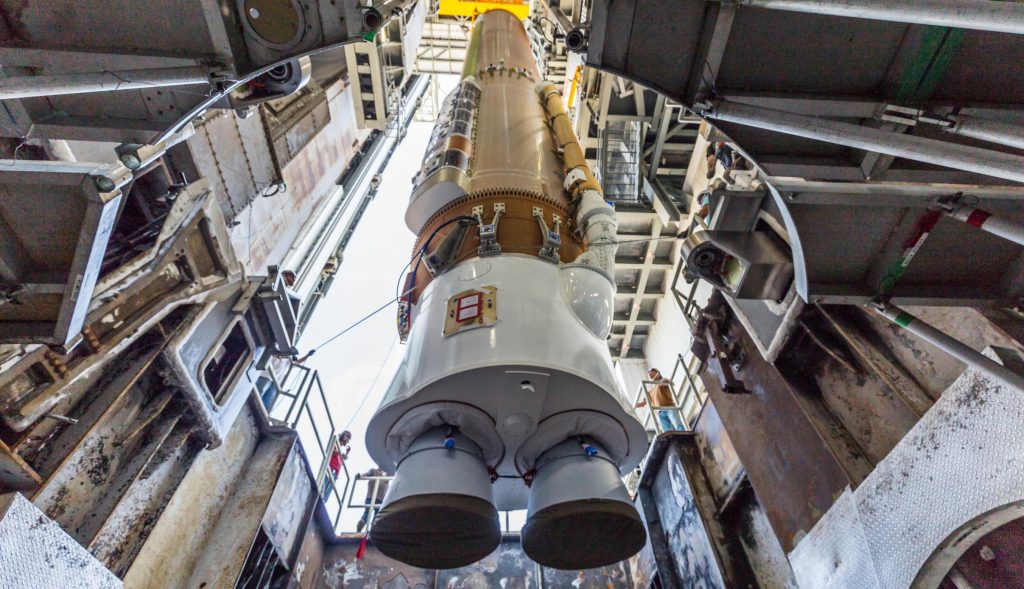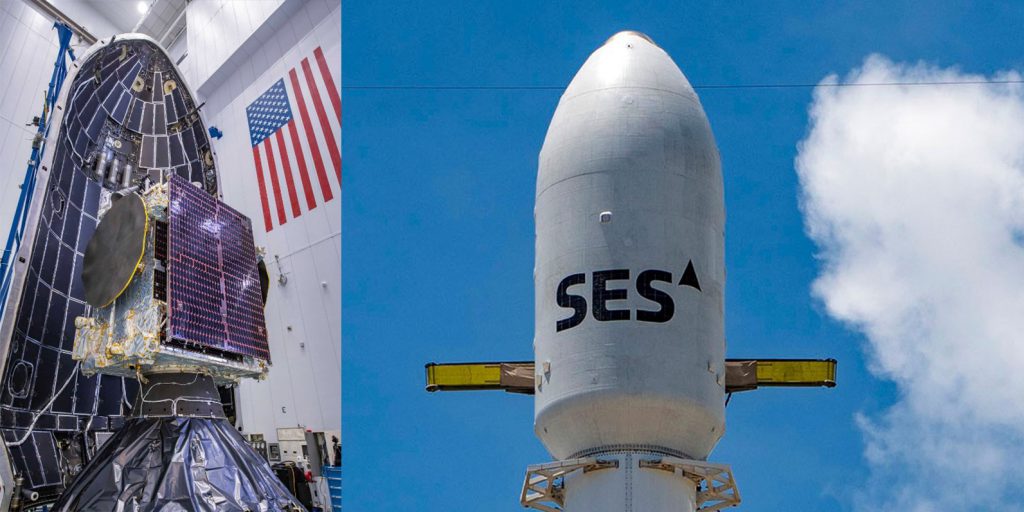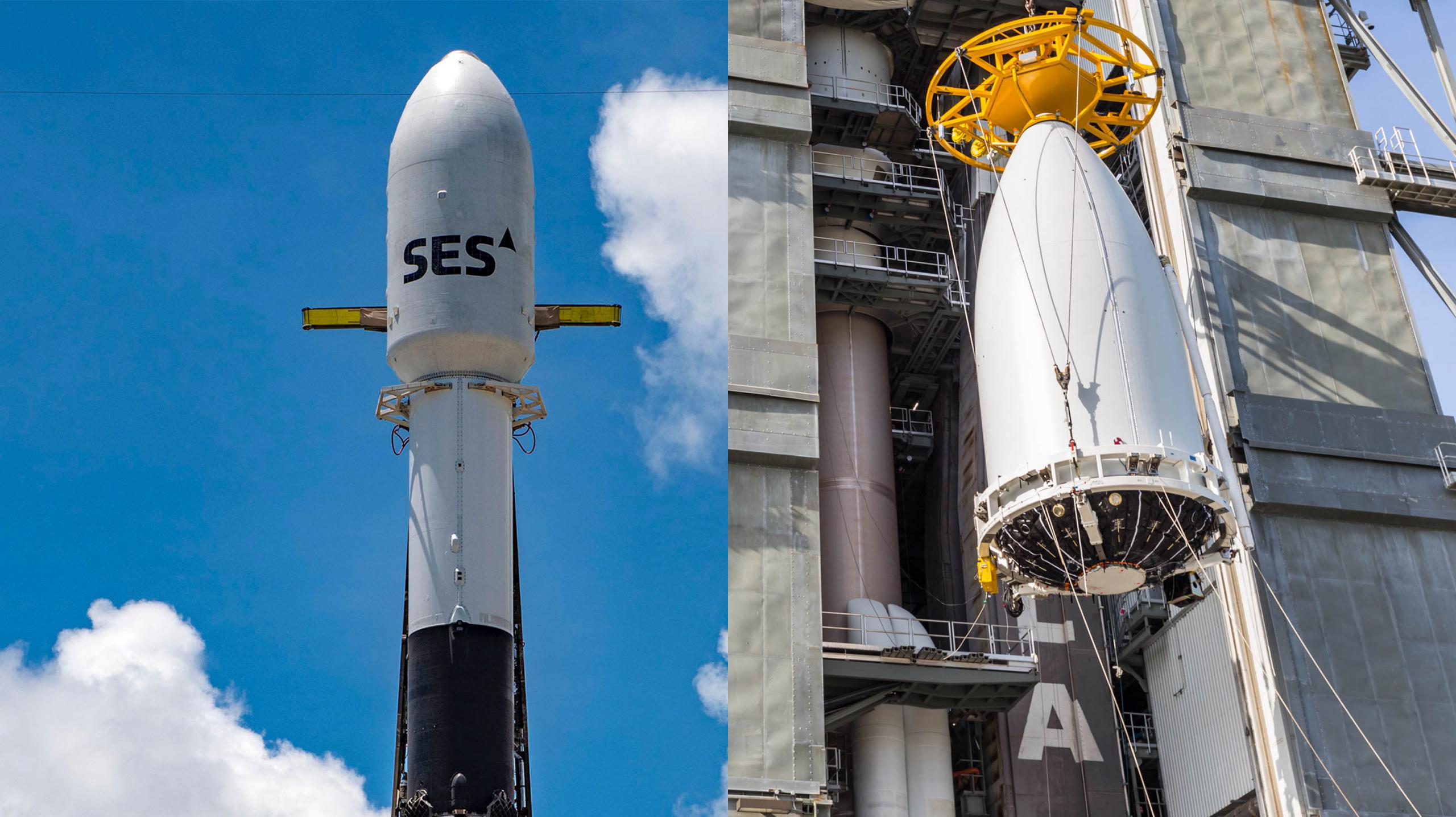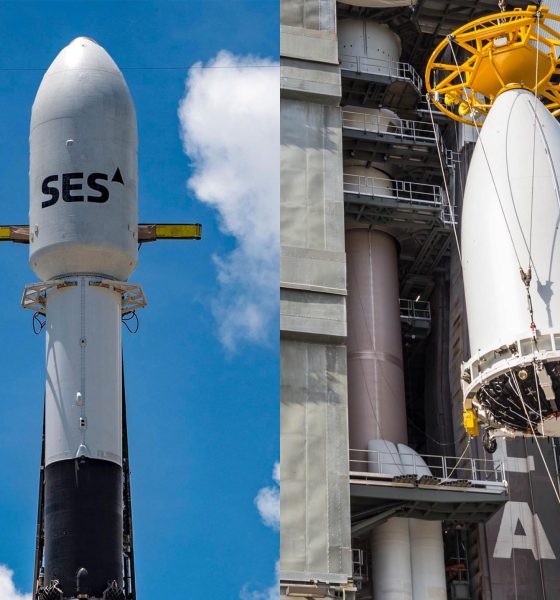SpaceX and competitor United Launch Alliance (ULA) are on track to launch their Falcon 9 and Atlas V rockets less than 25 hours apart.
Slightly delayed from its initial target of June 27th or 28th, SpaceX confirmed on Tuesday that a Falcon 9 rocket is ready to launch the European-built SES-22 no earlier than (NET) 5:04 pm EDT (21:04 UTC) on Wednesday, June 29th. Just 1.5 miles (2.4 km) to the north of SpaceX’s Cape Canaveral Space Force Station (CCSFS) LC-40 pad, ULA says it’s also on track to launch an Atlas V 541 rocket carrying a batch of rideshare payloads for the US military as early as 6pm EDT (22:00 UTC), Thursday, June 30th.
Both Falcon 9 and Atlas V will be carrying satellites destined for geostationary orbit (GEO), a location roughly 36,000 kilometers (~22,250 mi) above Earth’s surface where spacecraft orbit at the exact same speed as Earth’s rotation. As a result, spacecraft in GEO effectively hover in one spot in the sky to a ground observer, which makes the orbit optimal for some kinds of Earth observation and communications missions. SES-22 is a relatively ordinary commercial GEO communications satellite. ULA’s USSF-12 mission will carry a Wide Field Of View (WFOV) missile launch detection satellite and a mysterious secondary payload called the “USSF-12 Ring,” which ULA says is “a classified mission to demonstrate future technology for the Department of Defense.”

USSF-12’s Atlas V rocket will cost the military roughly $175 million and, like all other Atlas launch vehicles, is fully expendable. The Atlas V booster uses refined kerosene (RP-1) fuel and liquid oxygen oxidizer and is powered by a Russian-built RD-180 engine. The rocket’s Centaur upper stage uses liquid hydrogen (LH2) and LOx propellant and can be powered by one or two US-built RL-10 engines. ULA augments that basic Atlas V variant’s relatively poor performance by adding anywhere from 1-5 solid rocket boosters at its base, which can double the total payload a given Atlas V can launch to most Earth orbits.
Thanks in large part to the greater efficiency of Atlas V’s hydrolox Centaur upper stage, the high-end variants of the rocket with four or five SRBs are capable of launching a significant payload (~3.9 tons or ~8600 lb) directly to GEO, which is where USSF-12 will be heading. Falcon 9 will launch SES-22 to a less challenging geostationary transfer orbit (GTO), which leaves a small portion of the orbit-raising process to the payload.

In return, SpaceX will be able to recover and reuse Falcon 9’s booster and payload fairing and SES will pay more like $50-70 million (and a few extra months) to get its satellite to GEO. It’s quite likely that Falcon 9 would be able to launch a few tons directly to GEO in a fully-expendable configuration, but SpaceX’s Falcon Heavy rocket is able to offer even better direct-to-GEO performance for a similar price by expending one of its three Falcon 9-derived boosters, so the company has never tried to sell that service for Falcon 9.
Tune in below around 4:50 pm EDT (20:50 UTC) to watch SpaceX’s 27th launch of 2022 live. ULA will begin streaming Atlas V’s USSF-12 launch around 24 hours later.

News
Tesla FSD fleet is nearing 7 billion total miles, including 2.5 billion city miles
As can be seen on Tesla’s official FSD webpage, vehicles equipped with the system have now navigated over 6.99 billion miles.

Tesla’s Full Self-Driving (Supervised) fleet is closing in on almost 7 billion total miles driven, as per data posted by the company on its official FSD webpage.
These figures hint at the massive scale of data fueling Tesla’s rapid FSD improvements, which have been quite notable as of late.
FSD mileage milestones
As can be seen on Tesla’s official FSD webpage, vehicles equipped with the system have now navigated over 6.99 billion miles. Tesla owner and avid FSD tester Whole Mars Catalog also shared a screenshot indicating that from the nearly 7 billion miles traveled by the FSD fleet, more than 2.5 billion miles were driven inside cities.
City miles are particularly valuable for complex urban scenarios like unprotected turns, pedestrian interactions, and traffic lights. This is also the difference-maker for FSD, as only complex solutions, such as Waymo’s self-driving taxis, operate similarly on inner-city streets. And even then, incidents such as the San Francisco blackouts have proven challenging for sensor-rich vehicles like Waymos.
Tesla’s data edge
Tesla has a number of advantages in the autonomous vehicle sector, one of which is the size of its fleet and the number of vehicles training FSD on real-world roads. Tesla’s nearly 7 billion FSD miles then allow the company to roll out updates that make its vehicles behave like they are being driven by experienced drivers, even if they are operating on their own.
So notable are Tesla’s improvements to FSD that NVIDIA Director of Robotics Jim Fan, after experiencing FSD v14, noted that the system is the first AI that passes what he described as a “Physical Turing Test.”
“Despite knowing exactly how robot learning works, I still find it magical watching the steering wheel turn by itself. First it feels surreal, next it becomes routine. Then, like the smartphone, taking it away actively hurts. This is how humanity gets rewired and glued to god-like technologies,” Fan wrote in a post on X.
News
Tesla starts showing how FSD will change lives in Europe
Local officials tested the system on narrow country roads and were impressed by FSD’s smooth, human-like driving, with some calling the service a game-changer for everyday life in areas that are far from urban centers.

Tesla has launched Europe’s first public shuttle service using Full Self-Driving (Supervised) in the rural Eifelkreis Bitburg-Prüm region of Germany, demonstrating how the technology can restore independence and mobility for people who struggle with limited transport options.
Local officials tested the system on narrow country roads and were impressed by FSD’s smooth, human-like driving, with some calling the service a game-changer for everyday life in areas that are far from urban centers.
Officials see real impact on rural residents
Arzfeld Mayor Johannes Kuhl and District Administrator Andreas Kruppert personally tested the Tesla shuttle service. This allowed them to see just how well FSD navigated winding lanes and rural roads confidently. Kruppert said, “Autonomous driving sounds like science fiction to many, but we simply see here that it works totally well in rural regions too.” Kuhl, for his part, also noted that FSD “feels like a very experienced driver.”
The pilot complements the area’s “Citizen Bus” program, which provides on-demand rides for elderly residents who can no longer drive themselves. Tesla Europe shared a video of a demonstration of the service, highlighting how FSD gives people their freedom back, even in places where public transport is not as prevalent.
What the Ministry for Economic Affairs and Transport says
Rhineland-Palatinate’s Minister Daniela Schmitt supported the project, praising the collaboration that made this “first of its kind in Europe” possible. As per the ministry, the rural rollout for the service shows FSD’s potential beyond major cities, and it delivers tangible benefits like grocery runs, doctor visits, and social connections for isolated residents.
“Reliable and flexible mobility is especially vital in rural areas. With the launch of a shuttle service using self-driving vehicles (FSD supervised) by Tesla in the Eifelkreis Bitburg-Prüm, an innovative pilot project is now getting underway that complements local community bus services. It is the first project of its kind in Europe.
“The result is a real gain for rural mobility: greater accessibility, more flexibility and tangible benefits for everyday life. A strong signal for innovation, cooperation and future-oriented mobility beyond urban centers,” the ministry wrote in a LinkedIn post.
News
Tesla China quietly posts Robotaxi-related job listing
Tesla China is currently seeking a Low Voltage Electrical Engineer to work on circuit board design for the company’s autonomous vehicles.

Tesla has posted a new job listing in Shanghai explicitly tied to its Robotaxi program, fueling speculation that the company is preparing to launch its dedicated autonomous ride-hailing service in China.
As noted in the listing, Tesla China is currently seeking a Low Voltage Electrical Engineer to work on circuit board design for the company’s autonomous vehicles.
Robotaxi-specific role
The listing, which was shared on social media platform X by industry watcher @tslaming, suggested that Tesla China is looking to fill the role urgently. The job listing itself specifically mentions that the person hired for the role will be working on the Low Voltage Hardware team, which would design the circuit boards that would serve as the nervous system of the Robotaxi.
Key tasks for the role, as indicated in the job listing, include collaboration with PCB layout, firmware, mechanical, program management, and validation teams, among other responsibilities. The role is based in Shanghai.
China Robotaxi launch
China represents a massive potential market for robotaxis, with its dense urban centers and supportive policies in select cities. Tesla has limited permission to roll out FSD in the country, though despite this, its vehicles have been hailed as among the best in the market when it comes to autonomous features. So far, at least, it appears that China supports Tesla’s FSD and Robotaxi rollout.
This was hinted at in November, when Tesla brought the Cybercab to the 8th China International Import Expo (CIIE) in Shanghai, marking the first time that the autonomous two-seater was brought to the Asia-Pacific region. The vehicle, despite not having a release date in China, received a significant amount of interest among the event’s attendees.










